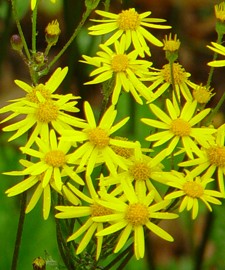 Ragwort is a semi-evergreen herbaceous perennial native to eastern North America where it grows in such places as the edges of streams, rivers, and ponds, wet to moist meadows and deciduous woodlands, and swamps. The plants form a basal rosette of leaves six to eight inches across. Each leaf is heart-shaped to oval, glossy, dark green with a purple tinge, and two to three inches long by two inches wide. A hairless stem arises from the the center of the rosette with two to three alternate leaves and produces a terminal flat topped cluster of small yellow daisy-like flowerheads in spring that are attractive to butterflies. Each flowerhead is about one inch across and consists of yellow disc flower surrounded by yellow ray flowers. Numerous small seeded fruits called achenes follow the flowers and have tufts of white hair that facilitate wind dispersal. The root system consists of fibrous roots and rhizomes that allow the plant to colonize. Golden ragwort is an excellent choice for the wettest and medium moist areas of a rain garden and adds a glow to a woodland planting when planted en mass. It grows well in part shade and can survive in full sun if given plenty of moisture. The basal rosettes form an attractive groundcover when the plant is not in flower although they may get ratty looking in winter.
Ragwort is a semi-evergreen herbaceous perennial native to eastern North America where it grows in such places as the edges of streams, rivers, and ponds, wet to moist meadows and deciduous woodlands, and swamps. The plants form a basal rosette of leaves six to eight inches across. Each leaf is heart-shaped to oval, glossy, dark green with a purple tinge, and two to three inches long by two inches wide. A hairless stem arises from the the center of the rosette with two to three alternate leaves and produces a terminal flat topped cluster of small yellow daisy-like flowerheads in spring that are attractive to butterflies. Each flowerhead is about one inch across and consists of yellow disc flower surrounded by yellow ray flowers. Numerous small seeded fruits called achenes follow the flowers and have tufts of white hair that facilitate wind dispersal. The root system consists of fibrous roots and rhizomes that allow the plant to colonize. Golden ragwort is an excellent choice for the wettest and medium moist areas of a rain garden and adds a glow to a woodland planting when planted en mass. It grows well in part shade and can survive in full sun if given plenty of moisture. The basal rosettes form an attractive groundcover when the plant is not in flower although they may get ratty looking in winter.
 Type: Semi-evergreen herbaceous perennial
Type: Semi-evergreen herbaceous perennial
Bloom: Flat clusters of 1″ wide daisy-like flowers are produced in panicle or corymbs in spring on stems arising from basal foliage
Size: Basal rosette 6″ H x 6-18″ W; flowering stems 12-24″ H
Light: Part shade to full sun (with adequate water)
Soil: Rich in organic matter, moist to wet
Care: Low maintenance; remove flowering stems after flowering or seed dispersal for tidy look
Hardiness: Zones 3-8
Pests and Diseases: None of significance
Propagation: Seed, division
Companion Plants: Blue flag iris (Iris versicolor), Cinnamon fern (Osmunda cinnamomea), Marsh marigold (Caltha palustris), foam flower (Tiarella cordifolia), wild columbine (Aquilegia canadensis), wild blue phlox (phlox divaricataq)
